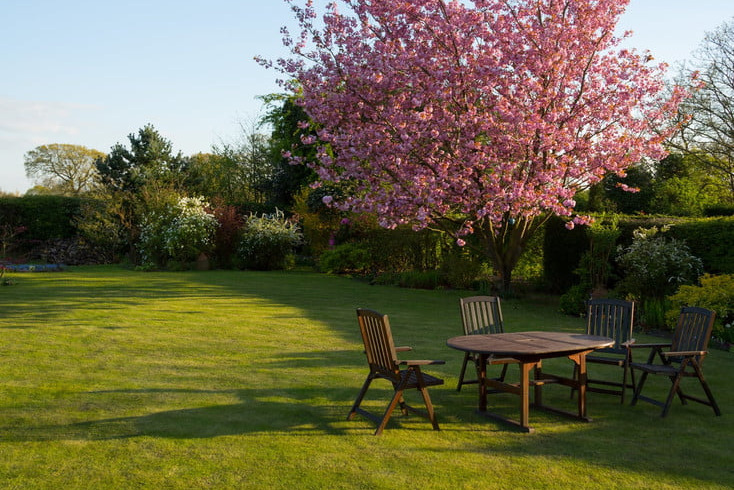If you’ve recently bought your first home and are, for the first time in your life, responsible for lawn care, the duty may feel overwhelming. Lawn care can get expensive and the last thing you want to do is ruin a perfectly good lawn because of inexperience. Not sure how to mow the grass or when to fertilize it? How often does grass need water? With these tips, your yard will be the envy of all your neighbors.

Tip #1: Find out what type(s) of grass you have
Several species of grass are common in the United States. Warm-season grasses, common in the southern U.S., grow in warm weather, then turn brown and go dormant in the colder months. Cool-season grasses grow best in moderate spring and fall temperatures, like those in the northern region, and go dormant in hot, dry conditions. The middle of the country often sees a mix of warm- and cool-season grasses.
The type of grass that grows in your yard influences important aspects of yard maintenance, such as how short to keep the blades and when to seed bare spots. If you’re not sure what type of grass is growing on your property, consult a landscaper or another lawn care professional.
Tip #2: Test your soil
Knowing the pH of your soil can help you determine how to care for it. If the pH of your soil isn’t optimal for the species you have, the grass can have trouble growing. Collect soil samples from different sections of your lawn, especially problem areas, and bring them to a Cooperative Extension lab for testing. You can also purchase a home test kit and run the experiment yourself.
With this information handy, seek advice from a lawn care professional on how to address any pH-related issues. They may advise you to use certain fertilizers to bring the soil’s acidity back into an ideal range.
Tip #3: Seed your lawn correctly
If there are bare spots across the yard, consult an expert to determine what type of grass seeds to use. You can use a different species than the one you currently have, as long as it can grow in your region’s climate.
It’s also important to seed your lawn at the right time. For warm-season grass, seed the yard in the spring or summer. To grow cool-season grass, seed the lawn during the spring or fall.
Amazing Landscape Services‘ Cameron Landry noted the importance of covering up freshly spread seed. “When we put grass seed down, we go over it with a top coat of soil. Seed on top of soil can wash away if you have a good rain, or birds can pick at it,” he explained.
Landry also stressed that after seeding, homeowners need patience. It may take two or three weeks to see results, but make sure you’re giving the seeds plenty of water in the meantime.
Tip #4: Know when and how to fertilize your lawn
Different types of fertilizer contain different percentages of nitrogen and other nutrients. As previously mentioned, your soil’s pH can determine which type of fertilizer is best for your lawn. Landry recommends finding a local company that makes fertilizers specifically designed for the conditions in your area.
It’s also important to give your grass the right amounts of fertilizer at appropriate intervals. Using the wrong amounts or reapplying too soon can damage your lawn.

Tip #5: Thatch your lawn and aerate the soil
When organic matter builds up faster than it decomposes, it forms a layer of thatch that protects the lawn from fluctuations in moisture and temperature. When thatch grows to be over an inch thick, however, it can keep nutrients, water, and air from getting deep down into the soil and make the lawn susceptible to disease and insect damage.
Removing thick layers of thatch can prevent those issues. Frank Faoro, a managing member of Allscapes NW LLC, recommends that you “fertilize [your lawn], water it, maybe thatch it once every couple years. If you keep your grass healthy, you shouldn’t need to thatch it too much on a regular basis.”
Landry also recommends aerating the soil to prevent it from becoming too dense. Aeration involves making holes in compacted soil so that water, air, and nutrients can reach the grass’s roots.
Tip #6: Choose a lawnmower carefully
There are several styles of lawnmowers, including ones that you can push and ones that you can ride around the yard. Ultimately, you should select one based on the size of yard you have. You might not mind pushing a lawnmower around a small lot, but it will be exhausting for a large piece of land.
Landry offered this advice: “If it takes you more than an hour to mow your lawn, you should possibly look into a riding option.” Your budget may also influence your decision, Landry noted.
Tip #7: Mow the grass often and don’t cut too much at once
When it comes to caring for a lawn, cutting the grass regularly is a must. If you mow at least once a week, you won’t have to worry about the yard becoming overgrown and out of control.
If you look around and realize that you didn’t mow the grass for a few weeks, you may be tempted to cut it short in one fell swoop, but be aware that this method can harm the blades. You should never cut more than one-third of the grass’s height at one time, so if your lawn gets extremely high, gradually cut it down to avoid shocking the vegetation.
Tip #8: Give the lawn a good watering – at the right time
Grass needs about an inch of water per week to stay healthy. How often you need to water your lawn will depend on the average rainfall in your area. The seasons play a role as well, so your lawn will need more water during the hot summer months, and you can cut back a little in the fall.
Shallow watering leads to shallow roots. Deeper watering and deep roots make for more resilient grass, so give your lawn a good soak so the water can penetrate far into the soil.
According to Landry, “One of the biggest [problems] is that people expect a green lawn, but they don’t water enough. A good rule of thumb is that if you lay out an empty tuna can in the yard where the sprinklers can hit it, it should fill up.”
Faoro noted the same problem: “A lot of times, people don’t water thoroughly enough or regularly enough.”
If you don’t have enough time to give your lawn a thorough watering, technology can help. “If it’s a high-end landscaped yard, looking into adding an irrigation system can save time and water,” Landry said. Some smart systems feature the ability to set a regular interval schedule from your phone, making this task easier than ever for homeowners.
The time of day when you water is also critically important. “Water in the morning or late afternoon,” Landry advised. This is when the sun isn’t too bright, so the moisture won’t evaporate quickly. In fact, watering in the middle of the day can burn the grass, since water magnifies the sun.
Tip #9: Protect your yard from weeds
Weeds steal water and nutrients from your lawn, so eliminating them is a key part of keeping your grass healthy. If you’re not sure if a particular type of vegetation is a weed, consult a lawn care professional. Also, reach out to an expert before you use any chemical treatments to ensure you won’t inadvertently harm the grass.
Landry pointed out that homeowners sometimes mistake grass for weeds, and customers often call believing they have crabgrass that they would like a landscaper to remove. More often than not, it’s just another native form of grass, not a weed.
Keeping weeds at bay also leads to healthy flower beds. Weeding and chemicals help, according to Landry, but bark provides an effective weed barrier as well.
Tip #10: Don’t let leaves pile up in your yard
If you live in an area with deciduous trees that lose their leaves in the fall, be diligent about raking the fallen foliage. “Keep the leaves off of [the lawn] in the fall,” Faoro recommended. “If leaves lie there, it’s no different than a piece of wood or a tarp on it. Leaves will kill the grass.”
Rake leaves or collect them with a leaf blower regularly, then put them in bags and dispose of them, ideally in a compost pile. You can also use a mulching lawnmower to chop the dead leaves into small pieces that can break down more easily, returning nutrients to the soil.
A lawn is easy to care for, but you have to be committed
As with any DIY project, don’t hesitate to call a professional for help. It’s better to ask questions and care for your lawn properly than to make crucial mistakes that you need to spend copious amounts of time and money repairing. Taking care of grass isn’t rocket science, but consistency is key. Homeowners often let their lawn go without a trim for several weeks, then find themselves struggling to get it under control and back in good condition.
Faoro concluded, “Overall, grass is the lowest maintenance thing you can put in your landscape. It requires diligent, frequent maintenance, but it’s the easiest thing to take care of. If you let it build up, it just gets worse.”





